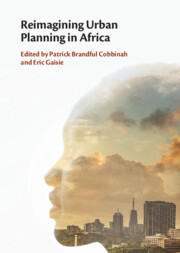Book contents
- Reimagining Urban Planning in Africa
- Reimagining Urban Planning in Africa
- Copyright page
- Contents
- Contributors
- Foreword
- Preface
- Acknowledgements
- Abbreviations
- Part I Understanding Sustainable Urban Planning in Africa
- Part II Case Studies on Urban Planning in African Countries
- 7 The Proliferation of Gated Communities
- 8 History, Practices, Challenges and Opportunities of Urban Planning in Zimbabwe
- 9 The Evolution and Nature of Urban Planning in Nigeria
- 10 Rethinking Urban Planning and Informal Settlement Upgrading
- 11 Urban Planning Challenges and Slum/Informal Housing Formation in Ogun State, Nigeria
- 12 The Proliferation of Slums in Cameroon
- 13 An Overview of Urban Planning in Tanzania
- Part III Sustainable Urban Planning in Africa
- Index
- References
13 - An Overview of Urban Planning in Tanzania
From Colonial to Post-colonial Urban Planning Practices
from Part II - Case Studies on Urban Planning in African Countries
Published online by Cambridge University Press: 07 December 2023
- Reimagining Urban Planning in Africa
- Reimagining Urban Planning in Africa
- Copyright page
- Contents
- Contributors
- Foreword
- Preface
- Acknowledgements
- Abbreviations
- Part I Understanding Sustainable Urban Planning in Africa
- Part II Case Studies on Urban Planning in African Countries
- 7 The Proliferation of Gated Communities
- 8 History, Practices, Challenges and Opportunities of Urban Planning in Zimbabwe
- 9 The Evolution and Nature of Urban Planning in Nigeria
- 10 Rethinking Urban Planning and Informal Settlement Upgrading
- 11 Urban Planning Challenges and Slum/Informal Housing Formation in Ogun State, Nigeria
- 12 The Proliferation of Slums in Cameroon
- 13 An Overview of Urban Planning in Tanzania
- Part III Sustainable Urban Planning in Africa
- Index
- References
Summary
Ideological rationalities and urban planning practices are inextricably linked, and urban planning practices draw insight from theoretical propositions. Through a review of relevant literature and documents, the chapter traces ideological changes and their influences on urban planning practices in colonial to post-colonial Tanzania. Colonial urban planning was based on modernist ideological rationalities drawing from layout planning, land use zoning and master planning. Post-colonial planning practices underwent changes in ideological rationalities from master planning to strategic planning. Master planning as modernist planning has always been an expert-led process based on means–ends and dualistic ideas. Strategic planning as post-modernist planning has been based on relations and pluralistic ideas. Non-implementation of master plans and strategic plans have rendered layout plans as the main spatial planning and decision-making tool. Contemporary planning realities are influenced by a multitude of challenges resulting in the emergence of piecemeal planning leading to uncoordinated urban forms, particularly in small towns.
- Type
- Chapter
- Information
- Reimagining Urban Planning in Africa , pp. 216 - 236Publisher: Cambridge University PressPrint publication year: 2023



